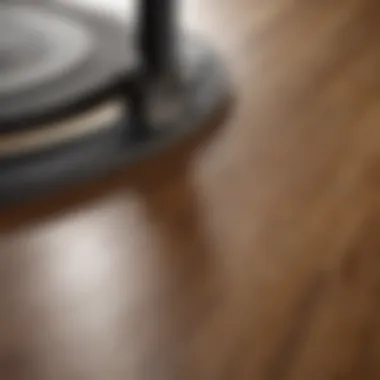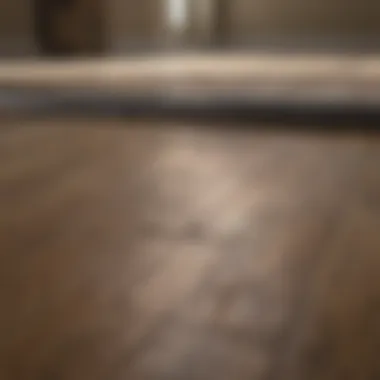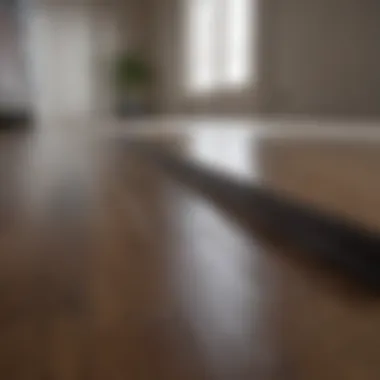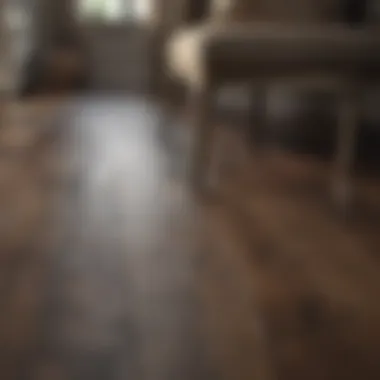Mastering Luxury Vinyl Plank Flooring Installation


Intro
The installation of luxury vinyl plank (LVP) flooring can transform a space. With its wood-like appearance and easy maintenance, it appeals to many homeowners. Understanding the process is crucial for achieving desired results. From planning to execution, each step requires careful consideration. Ensuring a successful installation involves precision, adequate preparations, and the right choice of materials.
Explanation of the Topic
LVP flooring has gained significant popularity in the home improvement industry. It combines aesthetics with functionality. Distinct from traditional hardwood, LVP provides water resistance and durability. This makes it suitable for various areas, including kitchens and bathrooms. Knowing how to install it properly enhances its benefits.
Importance of the Topic
Installing LVP flooring correctly is vital for longevity and performance. If not installed properly, issues may arise, leading to costly repairs or replacements. Moreover, a proper installation can increase the overall value of a home. Therefore, understanding the methods and techniques is essential for both professional installers and enthusiastic homeowners.
Common Challenges and Solutions
Despite its advantages, homeowners may encounter several challenges when installing LVP flooring.
Common Issues Faced
- Subfloor irregularities: Uneven subfloors can lead to complications during installation.
- Moisture issues: High moisture content in the air or subfloor can affect the adhesive and longevity of the flooring.
- Improper acclimation: Failing to acclimate the planks can result in expansion or contraction once installed.
Solutions and Tips
- Level the subfloor: Ensure it is flat and dry before installation.
- Conduct moisture tests: Use a moisture meter to understand the subfloor's condition.
- Acclimate planks: Leave the planks in the room for at least 48 hours. This allows them to adjust to the environment.
"Proper installation techniques can ensure that luxury vinyl plank flooring performs well for years to come."
Product Recommendations
Choosing the right products is crucial. Below are some top-quality LVP brands:
- Shaw: Known for durability and diverse style options. Their products can withstand high foot traffic.
- Karndean: Offers a variety of realistic wood looks that are stylish and practical.
- Mannington: Focuses on sustainable manufacturing, providing eco-friendly options that still look great.
Benefits and Features
Each brand provides unique benefits. For example, Shaw's products resist scratches and stains, while Karndean emphasizes artistic designs. Consider factors like warranty, texture, and longevity when selecting.
Step-by-Step Guides
To achieve a seamless installation, follow these practical steps:
- Preparation: Remove old flooring and clean the subfloor.
- Check moisture: Use a moisture meter on the subfloor.
- Acclimate your planks: Lay them flat in the installation room.
- Layout the planks: Plan your layout before gluing or clicking them into position.
- Install: Follow manufacturer's instructions on installation methods, whether click-lock or glue-down.
- Finishing touches: Add transitions or baseboards to complete the look.
Each step is vital. They contribute to the overall performance and aesthetics of your new flooring.
By understanding these aspects of LVP flooring installation, homeowners can create lasting results that add beauty and value to their homes.
Overview of Luxury Vinyl Plank Flooring
Luxury vinyl plank flooring, often referred to as LVP, has gained considerable recognition in recent years. Its blend of aesthetics and practicality makes it a preferred choice for homeowners and designers alike. Understanding this particular type of flooring is crucial for anyone considering a renovation or a new build.
Definition of Luxury Vinyl Plank Flooring
Luxury vinyl plank flooring is a type of resilient flooring composed of multiple layers designed to mimic the appearance of natural materials like wood or stone. Unlike traditional vinyl, LVP is known for its high-quality prints and textures that create a more realistic look. The core structure typically includes a backing layer, a vinyl layer with a design, and a protective wear layer on top that provides durability. This construction allows LVP to be both functional and visually appealing.
Benefits of LVP Flooring
Luxury vinyl plank flooring offers numerous advantages:
- Durability: It is resistant to dents, scratches, and stains, making it ideal for high-traffic areas in a home.
- Water Resistance: LVP can withstand moisture, which is beneficial for kitchens and bathrooms.
- Comfort: The softer texture provides comfort underfoot compared to harder flooring options.
- Ease of Installation: Many LVP products feature a click-lock mechanism, allowing for straightforward installation, even for DIY projects.
- Variety of Designs: Homeowners can choose from various styles, colors, and textures, enabling personalized aesthetics that match their interior design.
Common Applications of LVP Flooring
The versatility of LVP flooring allows it to be used in various settings:
- Residential: It’s popular in living rooms, kitchens, bathroom, and bedrooms due to its design options and durability.
- Commercial: Retail stores and offices often select LVP for its attractive appearance and lower maintenance costs.
- Hospitality: Hotels utilize LVP for its ability to endure wear while maintaining a luxurious look.
In summary, the overview of luxury vinyl plank flooring delineates its significance in the flooring market. It provides homeowners with ample options in both functionality and design, thus making a solid case for consideration in renovation projects.


Preparation for Installation
Preparation is a crucial stage when it comes to installing luxury vinyl plank (LVP) flooring. Proper preparation helps to avoid errors down the line and ensures that the installation process is smooth and efficient. A well-planned installation contributes to the longevity and performance of the flooring. In this section, we will explore several elements pertaining to preparation, which include selecting the right location, assessing subfloor conditions, and choosing the necessary tools and materials.
Choosing the Right Location
Selecting the correct location for LVP flooring installation can significantly impact the performance and durability of the planks. Consider the room’s functionality and expected foot traffic. For example, areas like kitchens and bathrooms may benefit from LVP’s water-resistant properties. Additionally, if the planks are going in a space with direct sunlight, it is essential to keep this in mind as UV rays can change the color of some flooring materials over time.
Think about factors such as humidity and temperature fluctuations. Rooms that are prone to high moisture levels should feature LVP specifically designed to endure such conditions. The right placement along with proper acclimation will result in a floor that looks good and lasts.
Assessing the Subfloor Conditions
A sound subfloor is a foundation for a successful LVP installation. Before proceeding, assess the condition of the existing subfloor. Check for any irregularities, such as bumps or dips, and ensure that it is dry and clean. A compromised subfloor can lead to issues like warping or an uneven surface that detracts from the floor’s overall aesthetic and performance.
If the subfloor shows signs of damage, repairs should be made before installing LVP. It is essential to also measure any moisture levels in the subfloor to confirm that they are within acceptable limits to avoid future flooring problems.
Selecting Necessary Tools and Materials
When it comes to LVP flooring installation, having the right tools and materials at hand can make a significant difference in the ease of the process.
Cutting Tools
Cutting tools play a fundamental role in achieving precise dimensions for vinyl planks. A popular choice among installers is the utility knife, which allows for remarkable control and straight cuts. Another tool worth considering is a laminate cutter, which offers clean edges with minimal effort. The unique feature of these tools is their ability to make accurate adjustments, ensuring that each plank fits snugly against adjacent pieces. However, be aware that using cutting tools improperly can lead to jagged edges or uneven cuts, so it is important to take time for practices.
Measuring Instruments
Measuring instruments, such as tape measures and square tools, are critical for ensuring accuracy during LVP installation. Their primary function is to enable proper layout, which is key for alignment of the planks. The best characteristic of measuring instruments is their ease of use and precision. Proper measurement helps to avoid complications later, such as misaligned patterns or wasted material. Never underestimate the necessity of accurate measuring, as it can save both time and frustration.
Adhesives and Underlayments
Choosing the right adhesives and underlayments contributes significantly to the overall installation quality. Underlayments can provide sound insulation, moisture control, and cushioning underfoot. Vinyl flooring might often require a specific adhesive for proper bonding, which varies significantly based on the subfloor type. The unique feature of high-quality adhesives is their ability to create a strong bond without compromising the flooring’s flexibility. On the other hand, using improper adhesives can result in peeling or bubbling over time.
The preparation stage sets the groundwork for a successful luxury vinyl plank flooring installation. By focusing on location, subfloor conditions, and the necessary tools and materials, installers can ensure that their approach is comprehensive and effective.
Steps for Installing LVP Flooring
Understanding the steps involved in installing luxury vinyl plank (LVP) flooring is crucial to achieve a professional finish. Each phase contributes to the overall durability and aesthetic appeal of the floor. Every step matters, from preparing the subfloor to laying the final plank. The installation process can impact the longevity of the flooring and the satisfaction of the homeowner, making attention to detail indispensable.
Preparing the Subfloor
The subfloor acts as the foundation for the LVP. A well-prepared subfloor enhances the performance of the flooring. Begin by ensuring it is clean, dry, and free from imperfections. Any dips or humps can lead to uneven flooring and future issues.
- Remove all debris and dust.
- Check for moisture, which can cause damage.
Evaluate the surface for any cracks or gaps. Repair these with an appropriate filler to create a smooth surface. A flat subfloor provides the necessary support, reduces noise, and prolongs the life of the vinyl planks.
Acclimating the Vinyl Planks
Acclimation is a significant step that often gets overlooked. Luxury vinyl planks must adapt to the new environment before installation. This process allows the material to expand or contract according to the room's temperature and humidity.
- Store the planks in the room where they will be installed for at least 48 hours.
- Keep the planks in their original packaging until ready to install.
Accurate acclimation prevents buckling or gaps post-installation. Proper adjustments in the climate reduce the risk of stress on the flooring, which impacts its visual appeal and longevity.
Installing Underlayment
The underlayment serves as a protective barrier and provides insulation. It can help with noise reduction and acts as a moisture barrier if needed. Selecting the right type of underlayment is essential for ensuring the best performance of the vinyl flooring.
- Choose an underlayment compatible with LVP materials.
- Ensure proper thickness based on the subfloor type.
Correct underlayment installation leads to a smoother surface and better insulation. It enhances comfort, making the floor feel more pleasant underfoot.
Laying the Planks
This phase requires precision and methodical execution. Properly laying the planks ensures integrity and aesthetic value in flooring. Starting rows, cutting planks to fit, and securing planks in place are all critical components of this process.
Starting Rows


Starting rows set the alignment for the entire project. A straight initial row establishes a reference for the rest of the installation. This is crucial in ensuring a seamless appearance throughout the flooring.
- Measure from the wall to determine the optimal starting point.
- Ensure that the first plank is straight before continuing.
A well-placed starting row simplifies the remainder of the installation process, leading to greater overall satisfaction with the result.
Cutting Planks to Fit
Precision cutting is vital for a perfect finish. When dealing with various room shapes and sizes, cutting planks to fit becomes necessary for achieving a snug fit around edges and corners.
- Use a reliable cutting tool, like a utility knife or a plank cutter.
- Measure twice before making any cuts.
Accurate cuts help avoid gaps or overlaps, ensuring the flooring looks professional. Proper techniques reduce waste, keeping costs down.
Securing Planks in Place
Securing the planks is essential for stability. Loose planks can lead to movement, causing damage over time. Employ proper techniques to ensure that each plank stays in place.
- Use a tapping block to secure each plank snugly against its neighbor.
- Avoid using excessive force, which could damage the planks.
Correctly secured planks lead to a cohesive floor that can withstand typical household activities while maintaining an appealing look.
Dealing with Obstacles
Obstacles such as pipes, vents, door frames, and thresholds need special consideration during installation. These elements can complicate the process and need thoughtful approaches to ensure a polished finish.
Pipes and Vents
Whenever there are pipes or vents, it is crucial to plan for their placement adequately. Failing to account for these can result in flooring issues or unsightly gaps.
- Measure carefully to create the right cutouts.
- Use a jigsaw for precise cuts around pipes.
Strategically accounting for these features allow for a neat finish and avoids potential maintenance problems in the future.
Door Frames and Thresholds
Door frames and thresholds require special attention as well. These parts often dictate how planks should be cut and placed, ensuring smooth transitions between rooms.
- Determine the correct height for each plank to align with door frames and thresholds.
- Trim planks if necessary, ensuring a fluid transition between areas.
The right approach helps avoid tripping hazards and ensures an aesthetically pleasing appearance across transitions.
With each step methodically approached, the installation of luxury vinyl plank flooring becomes more manageable, leading to a successful and pleasing end result.
Finalizing the Installation
Finalizing the installation of luxury vinyl plank flooring is an essential step that ensures not only aesthetics but also the longevity of your flooring. This phase brings the work to a close and allows for the full appreciation of your newly installed planks. Proper finishing can prevent issues such as warping, gaps, or other forms of damage that may arise from improper handling post-installation.
Trimming and Finishing Touches
The trimming phase focuses on giving your flooring a neat and polished appearance. This involves cutting and fitting baseboards or quarter rounds around edges. It is crucial to choose the right kind of trim that matches your flooring in color and design. This step can greatly enhance the overall look of the room.
To perform this task effectively, follow these guidelines:
- Measure the area where trim is to be installed. Always double-check your measurements before cutting.
- Use a miter saw for precise cuts on corners. Proper angles will result in clean joints when pieces meet.
- Secure trim using finishing nails or adhesive suitable for your trim material.
- If required, fill any small gaps or nail holes with wood filler, and paint or stain to blend in.
"Finishing touches can add character to a room and conceal imperfections that may have occurred during installation."
Making sure everything is aligned helps to maintain the seamless look that luxury vinyl plank flooring is known for.
Cleaning and Maintaining the Floor
After trimming is complete, cleaning the newly installed floor becomes a priority. Luxury vinyl planks are relatively low maintenance, but initial cleaning is essential to remove dust, debris, and any residues from installation.
To effectively clean your LVP floors, follow these practices:
- Use a soft broom or vacuum to remove loose dirt. Avoid vacuums with a beater bar as they may scratch the surface.
- For deeper cleaning, use a mop dampened with a mild cleaning solution specifically meant for vinyl flooring. Ensure the mop is not overly wet to avoid water damage.
- Regular maintenance involves sweeping or vacuuming weekly, with occasional damp mopping to keep your floors looking their best.


Additionally, consider these long-term maintenance tips:
- Avoid harsh chemicals. Use cleaners that are safe for vinyl to prevent deterioration.
- Place mats at entry points to minimize dirt accumulation.
- Refrain from dragging furniture across the floor. Instead, lift or use furniture pads to protect the surface.
By prioritizing cleaning and maintenance, you ensure your flooring remains not only beautiful but also functional for years to come.
Post-Installation Considerations
After successfully installing luxury vinyl plank (LVP) flooring, engaging in post-installation considerations is crucial. These practices ensure the durability and appeal of your new flooring, protecting your investment. This section will dive into essential components such as warranty information and care instructions, as well as long-term maintenance tips to keep your flooring in optimal condition.
Warranty and Care Instructions
Understanding the warranty of your LVP flooring is vital. Most manufacturers offer various warranties, which may cover different aspects such as wear, moisture, fading, and installation. Review the warranty conditions carefully to know what is protected and for how long. Keeping the warranty in good standing often requires following specific care instructions provided by the manufacturer.
Care instructions typically emphasize regular cleaning and maintenance practices. Here are some general guidelines:
- Use a damp mop for cleaning: Avoid soaking the floor as excessive water can damage the material.
- Choose the right cleaning solutions: Use products recommended by the manufacturer. Avoid harsh chemicals that can harm the finish.
- Protect against scratches: Use pads under furniture legs to minimize damage. Keeping the floor free of dirt and debris can also prevent scratches.
Following these instructions not only extends the life of your flooring but also helps maintain its aesthetic appeal.
Long-Term Maintenance Tips
Maintaining your LVP flooring over the years involves consistent care and attention. Here are useful long-term maintenance tips:
- Regular Cleaning: Develop a routine to clean the floor at least once a week. Daily sweeping can prevent dirt buildup, while mopping should occur weekly.
- Immediate Spill Cleanup: Address spills promptly to prevent staining or damage. Wipe up liquids with a soft cloth, and use a recommended cleaner if necessary.
- Avoid Heavy Objects: Be cautious with heavy items. Regularly moving heavy furniture can cause dents or damage.
- Inspect Regularly: Check for any signs of damage, such as loose planks or wear patterns. Early identification of issues can prevent more significant problems down the road.
By following these long-term maintenance tips and care instructions, homeowners can enjoy the beauty and functionality of their luxury vinyl plank flooring for years to come.
Common Mistakes to Avoid
When undertaking the installation of luxury vinyl plank (LVP) flooring, there are key mistakes that can undermine the entire effort. Recognizing and avoiding these errors is crucial not only for achieving a seamless installation but also for ensuring the longevity and aesthetic appeal of your floor. This section addresses three of the most common pitfalls that DIY enthusiasts and even some professionals may encounter during the installation process.
Ignoring Subfloor Preparation
Subfloor preparation is a foundational step that can significantly impact the final product. Many may underestimate the importance of a clean, flat surface. An unprepared subfloor can lead to issues such as warping, unevenness, or gaps between planks.
First, you should ensure the subfloor is free from debris, dust, and moisture. Any contaminant can inhibit the adhesion of the planks and compromise the look and functionality of the entire floor. Additionally, you must check if your subfloor is level. An uneven subfloor can result in shifting planks, which may create an uncomfortable and noisy walking experience.
Invest time in this preparation step. A well-prepared subfloor lays the groundwork for a successful installation and a beautiful finish.
Incorrect Acclimation Practices
Acclimating LVP before installation is another step that some may overlook. This involves allowing the planks to adjust to the environment where they will be installed. Failure to do this can cause the planks to expand or contract after installation, leading to buckling or gapping.
Generally, you should allow the planks to acclimate to the room temperature for at least 48 hours. Store the planks in a space where they will be installed, away from direct sunlight or extreme temperatures. This minimizes surprises after installation.
Before you proceed, verify that the room’s humidity and temperature align with the manufacturer’s recommendations. Each brand may have specific instructions that must be adhered to.
Improper Installation Techniques
Installation techniques play a vital role in the overall look and durability of LVP flooring. Common mistakes include not following the correct methods for laying planks or securing them in place.
One common error involves not staggering the seams between rows. This style not only enhances the aesthetic but also strengthens the floor structure. Additionally, using the wrong adhesive or failing to secure edges correctly can introduce gaps or even cresting.
Take the time to follow the manufacturer’s instructions closely. Pay attention to the recommended installation pattern and best practices. This will conclude not just a visually appealing job but ensure your floor can withstand daily use.
"Installation is not just about placing planks; it's about ensuring they work well together to provide a beautiful and lasting surface."
End
In the installation of luxury vinyl plank (LVP) flooring, understanding the conclusion is crucial. It offers a chance to synthesize the entire process, highlighting key elements and ensuring that the work is appreciated in its entirety. By revisiting the steps taken from preparation to completion, home owners and DIY enthusiasts can grasp the importance of each phase in achieving a successful installation.
Recap of Key Points
The installation of LVP flooring involves several critical steps. From choosing the right location to ensuring proper acclimation and installation techniques, each aspect plays a vital role. To recap:
- Proper Preparation: The importance of preparing the subfloor cannot be overstated. Failure to assess subfloor conditions can lead to poor results.
- Acclimation of Vinyl Planks: Allowing the planks to adapt to room temperature and humidity prevents buckling or warping after installation.
- Installation Techniques: Correct methods and tools will ensure that the planks fit properly, yielding an aesthetically pleasing finish.
"A well-installed floor can transform the look and feel of any space, increasing both comfort and potential resale value."
Incorporating these key points into the installation process is beneficial, as it helps solidify the foundation of knowledge required for such projects.
Final Thoughts on LVP Installation
The conclusion serves to summarize not only the process but the benefits of hardwood alternatives such as LVP flooring. Homeowners who choose to engage in LVP installation often do so for reasons such as durability, aesthetics, and cost-effectiveness. These practical benefits, when combined with the satisfaction of a job completed correctly, can greatly enhance one’s living space.
In summary, LVP flooring is a versatile choice that requires careful planning and consideration throughout the installation process. Each stage carries weight and significance in ensuring a finished floor that meets expectations and stands the test of time. Not only does understanding the installation process promote successful outcomes, but it also empowers homeowners to take pride in their spaces.







